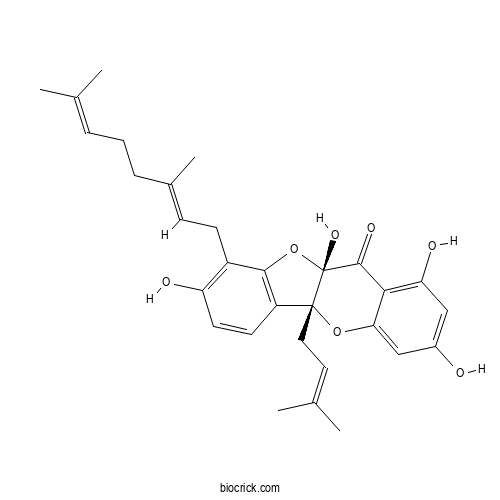Sanggenol GCAS# 202526-52-1 |

Quality Control & MSDS
3D structure
Package In Stock
Number of papers citing our products

| Cas No. | 202526-52-1 | SDF | Download SDF |
| PubChem ID | 101098714 | Appearance | Powder |
| Formula | C30H34O7 | M.Wt | 506.6 |
| Type of Compound | Phenols | Storage | Desiccate at -20°C |
| Solubility | Soluble in Chloroform,Dichloromethane,Ethyl Acetate,DMSO,Acetone,etc. | ||
| Chemical Name | (5aR,10aS)-9-[(2E)-3,7-dimethylocta-2,6-dienyl]-1,3,8,10a-tetrahydroxy-5a-(3-methylbut-2-enyl)-[1]benzofuro[3,2-b]chromen-11-one | ||
| SMILES | CC(=CCCC(=CCC1=C(C=CC2=C1OC3(C2(OC4=CC(=CC(=C4C3=O)O)O)CC=C(C)C)O)O)C)C | ||
| Standard InChIKey | USZRAMUXEQHMID-SIFBFURESA-N | ||
| Standard InChI | InChI=1S/C30H34O7/c1-17(2)7-6-8-19(5)9-10-21-23(32)12-11-22-27(21)37-30(35)28(34)26-24(33)15-20(31)16-25(26)36-29(22,30)14-13-18(3)4/h7,9,11-13,15-16,31-33,35H,6,8,10,14H2,1-5H3/b19-9+/t29-,30-/m1/s1 | ||
| General tips | For obtaining a higher solubility , please warm the tube at 37 ℃ and shake it in the ultrasonic bath for a while.Stock solution can be stored below -20℃ for several months. We recommend that you prepare and use the solution on the same day. However, if the test schedule requires, the stock solutions can be prepared in advance, and the stock solution must be sealed and stored below -20℃. In general, the stock solution can be kept for several months. Before use, we recommend that you leave the vial at room temperature for at least an hour before opening it. |
||
| About Packaging | 1. The packaging of the product may be reversed during transportation, cause the high purity compounds to adhere to the neck or cap of the vial.Take the vail out of its packaging and shake gently until the compounds fall to the bottom of the vial. 2. For liquid products, please centrifuge at 500xg to gather the liquid to the bottom of the vial. 3. Try to avoid loss or contamination during the experiment. |
||
| Shipping Condition | Packaging according to customer requirements(5mg, 10mg, 20mg and more). Ship via FedEx, DHL, UPS, EMS or other couriers with RT, or blue ice upon request. | ||

Sanggenol G Dilution Calculator

Sanggenol G Molarity Calculator
| 1 mg | 5 mg | 10 mg | 20 mg | 25 mg | |
| 1 mM | 1.9739 mL | 9.8697 mL | 19.7394 mL | 39.4789 mL | 49.3486 mL |
| 5 mM | 0.3948 mL | 1.9739 mL | 3.9479 mL | 7.8958 mL | 9.8697 mL |
| 10 mM | 0.1974 mL | 0.987 mL | 1.9739 mL | 3.9479 mL | 4.9349 mL |
| 50 mM | 0.0395 mL | 0.1974 mL | 0.3948 mL | 0.7896 mL | 0.987 mL |
| 100 mM | 0.0197 mL | 0.0987 mL | 0.1974 mL | 0.3948 mL | 0.4935 mL |
| * Note: If you are in the process of experiment, it's necessary to make the dilution ratios of the samples. The dilution data above is only for reference. Normally, it's can get a better solubility within lower of Concentrations. | |||||

Calcutta University

University of Minnesota

University of Maryland School of Medicine

University of Illinois at Chicago

The Ohio State University

University of Zurich

Harvard University

Colorado State University

Auburn University

Yale University

Worcester Polytechnic Institute

Washington State University

Stanford University

University of Leipzig

Universidade da Beira Interior

The Institute of Cancer Research

Heidelberg University

University of Amsterdam

University of Auckland

TsingHua University

The University of Michigan

Miami University

DRURY University

Jilin University

Fudan University

Wuhan University

Sun Yat-sen University

Universite de Paris

Deemed University

Auckland University

The University of Tokyo

Korea University
- (-)-3-Hydroxy-p-menth-1-en-6-one
Catalog No.:BCX0455
CAS No.:78085-72-0
- 21,23-Dihydro-21-hydroxy-23-oxonomilinic acid methyl ester
Catalog No.:BCX0454
CAS No.:2243600-34-0
- 6'-O-Glucopyranosylpaeoniflorin
Catalog No.:BCX0453
CAS No.:1427054-21-4
- Zerumin B
Catalog No.:BCX0452
CAS No.:176050-49-0
- Isoscutellarein 8-O-glucuronide
Catalog No.:BCX0451
CAS No.:56317-09-0
- (2E,4E)-6-Hydroxy-2,6-dimethylhepta-2,4-dienal
Catalog No.:BCX0450
CAS No.:220766-63-2
- 7,4'-Dihydroxyflavone 7-O-glucoside
Catalog No.:BCX0449
CAS No.:20633-86-7
- Zerumin
Catalog No.:BCX0448
CAS No.:180680-70-0
- 14-Deoxyisocoronarin D
Catalog No.:BCX0447
CAS No.:189239-51-8
- Morofficinaloside
Catalog No.:BCX0446
CAS No.:78964-45-1
- Durianol A
Catalog No.:BCX0445
CAS No.:1941203-91-3
- 1,7-Di-O-Galloyl-D-sedoheptulose
Catalog No.:BCX0444
CAS No.:126622-78-4
- Sanggenon A
Catalog No.:BCX0457
CAS No.:76464-71-6
- Sanggenon M
Catalog No.:BCX0458
CAS No.:922080-11-0
- Breynioside A
Catalog No.:BCX0459
CAS No.:63555-02-2
- 6'-O-Glucopyranosylalbiflorin
Catalog No.:BCX0460
CAS No.:1001644-88-7
- (E)-14-Hydroxy-15-norlabda-8(17),12-dien-16-al
Catalog No.:BCX0461
CAS No.:114370-19-3
- Monardin C
Catalog No.:BCX0462
CAS No.:1262796-93-9
- 15-O-Ethylzerumin B
Catalog No.:BCX0463
CAS No.:1707019-00-8
- Alpinenone
Catalog No.:BCX0464
CAS No.:103425-23-6
- 6β-Hydroxy-7-epi-α-cyperone
Catalog No.:BCX0465
CAS No.:6851-55-4
- Zataroside A
Catalog No.:BCX0466
CAS No.:95645-53-7
- Procumboside A
Catalog No.:BCX0467
CAS No.:850894-16-5
- Moracin B
Catalog No.:BCX0468
CAS No.:67259-16-9
A strategy for screening of alpha-glucosidase inhibitors from Morus alba root bark based on the ligand fishing combined with high-performance liquid chromatography mass spectrometer and molecular docking.[Pubmed:29332820]
Talanta. 2018 Apr 1;180:337-345.
A new method based on ligand fishing combined with high-performance liquid chromatography quadrupole-time-of-flight mass spectrometer and molecular docking was established to screen alpha-glucosidase inhibitors from a traditional Chinese medicine Morus alba root bark. alpha-Glucosidase was immobilized on magnetic nanoparticles, used as a solid support to incubate with crude extract. After ligand fishing, the eluates were analyzed by high-performance liquid chromatography quadrupole-time-of-flight mass spectrometer, obtaining eleven ligands (1-4, 6-12) eventually. In order to discriminate the non-specific binders and discover powerful enzyme inhibitors, molecular docking was further performed and three of the eleven ligands were optimized to be excellent alpha-glucosidase inhibitors by the confirmation of isolation and bioassay of individual compounds. These three ligands, sanggenons G (6), O (7) and Sanggenol G (12) exhibited striking inhibitory activities with extremely low IC(50) values. The results suggest that established method will be applied to a wide range of target protein to screen potential bioactive constituents from herbal medicines.


